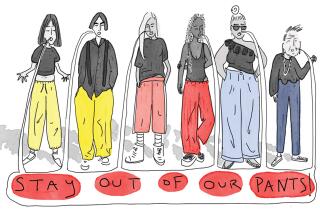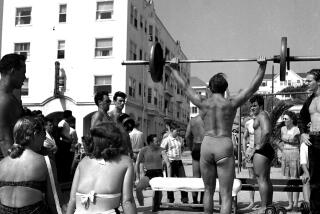Taking a Hard Look at the Hardbodies
WASHINGTON — Who says the hardbody look is worth it?
The current female ideal of steel buns and washboard bellies is just another fashion statement--an attempt by society to cram the widely varying forms of women’s bodies into one mold. And they won’t fit, says Joan Jacobs Brumberg of Cornell University.
“The hardbody ideal is very difficult for a lot of women,” Brumberg said. Many of us will never have certain kinds of physiques, no matter how hard we work at it.”
Although Brumberg applauds sports and exercise, she sees the hardbody physique as the latest outgrowth of a culture that puts looks ahead of character and morals.
It wasn’t always like this, said Brumberg, who traces changes in body fashions in her book, “The Body Project.” The early Victorians highlighted moral worth over appearance and considered it a sign of poor social background to have a body that appeared accustomed to hard physical activity, she said. But as women’s bodies began to appear more in advertising, and as bathrooms and mirrors appeared in more households, things changed, Brumberg said. Especially in the adventurous 1920s, a thin, girlish body became more fashionable as a type of self-expression, rebelling against Victorian strictures, she said. And clothes exposed more. The trend continues even now, Brumberg said. “The body is requiring more upkeep than ever before. It’s costly, it’s time-consuming.” But today’s fashions require it, she said.
So, while diaries from the Victorian era show girls concerned about good works and good character, today’s diaries show girls are caught up in good looks, shesaid.
The result stands the athletic ideal on its head. A healthy athleticism gets a girl involved in the pleasure of sports, not on sports solely as a way to shape her body, the researcher said.
But an expert on women in sports thinks women will stick with sports for reasons other than body image. A surge of girls and women into scholastic athletics since the 1970s, under the federal Title IX equal-access requirements, is unlikely to abate, said Donna Lopiano, executive director of the Women’s Sports Foundation in East Meadow, N.Y.
“What people seem to be missing about active women is that it is not a fitness-buff movement,” Lopiano said. “They are not doing it for a spouse or a boyfriend or for fashion’s sake. They are doing it for their own sake.”
In any case, the hardbody ideal seems to be changing as the media hold up more varied types of women’s bodies as admirable, Lopiano said. For instance, in the 1996 Atlanta Olympics, it wasn’t just the thin, hardbody gymnasts who got attention, she said--softball and soccer players with differing bodies also were stars.
And Barbara S. Harris, editor in chief of Shape magazine, does not accept the idea that the media dictate to women to exercise solely so they will look attractive. Women also are paying attention to research that shows the health benefits of exercise, she said.

